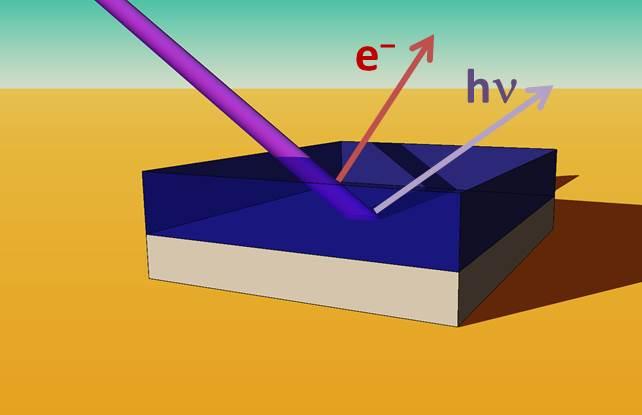Depletion and enrichment of chlorine in perovskites observed

X-ray spectroscopies have shown a higher chlorine concentration near the perovskite/TiO2 interface than throughout the rest of the perovskite film. Credit: D. Starr/HZB
These organometallic halide perovskites are low cost, easy to process, and have enormous potential for efficient solar energy conversion: power conversion efficiencies up to 20.1 % have already been reported. Pioneering work has been led by the group of Henry Snaith at the University of Oxford in the UK.
Chlorine tends to disappear
Optimal performance for these devices has been achieved with methylammonium lead halide absorbers which use a mixture of chlorine and iodine. Despite typical chlorine-to-iodine concentration ratios of 0.66 in the initial precursor solution, the perovskite films contain little or no chlorine. Depending on the processing procedures, chlorine tends to be depleted, whereas the iodine atoms remain in the material. Nevertheless, the chlorine seems to benefit the efficiency of the absorber material, but it is still not understood how and why.
Analysing deeper layers
Now, a team of HZB scientists has analysed samples from the Snaith group and unveiled how chlorine is distributed in the perovskite absorber layer. They used X-ray spectroscopies at the BESSY-II facility to probe the distribution of chlorine in a mixed halide, organic-inorganic perovskite absorber layer.
With hard X-ray photoelectron spectroscopy (HAXPES) experiments at the KMC-1 beamline they probed the surface of perovskite layers and found nearly no chlorine near the surface. With a different method, fluorescence yield X-ray absorption spectroscopy (FY-XAS), they probed more deeply into the layers of the sample.
“We have observed a higher concentration of chlorine near the perovskite/TiO2 interface than in the rest of the thin film”, David Starr, first author of the publication in Energy & Environmental Science explains.
Chlorine boosts efficiency
Chlorine may potentially play a role in mitigating the effects of vacancies, which favor recombination and charge carrier loss, or providing a better template on which to grow the perovskite film. “These results may help to understand the apparent beneficial effects of chlorine for perovskite solar cell device performance and could potentially provide a route to device optimization,” Marcus Bär, who heads the HZB team, says.
“The ultimate goal is to use this knowledge to tailor deposition processes and material compositions to achieve specific desirable properties; perhaps by completely understanding the beneficial role of chlorine in the Pb-based perovskite material, we can overcome some of the difficulties involved in replacing the Pb with a less toxic material.”
###
Publication: Energy Environ. Sci., 2015, 8, 1609, DOI: 10.1039/c5ee00403a
Direct observation of an inhomogeneous chlorine distribution in CH3NH3PbI3_xClx layers: surface depletion and interface enrichment. David E. Starr, Golnaz Sadoughi,
Evelyn Handick, Regan G. Wilks, Jan H. Alsmeier, Leonard Köhler, Mihaela Gorgoi, Henry J. Snaith and Marcus Bär
Media Contact
All latest news from the category: Materials Sciences
Materials management deals with the research, development, manufacturing and processing of raw and industrial materials. Key aspects here are biological and medical issues, which play an increasingly important role in this field.
innovations-report offers in-depth articles related to the development and application of materials and the structure and properties of new materials.
Newest articles

Properties of new materials for microchips
… can now be measured well. Reseachers of Delft University of Technology demonstrated measuring performance properties of ultrathin silicon membranes. Making ever smaller and more powerful chips requires new ultrathin…

Floating solar’s potential
… to support sustainable development by addressing climate, water, and energy goals holistically. A new study published this week in Nature Energy raises the potential for floating solar photovoltaics (FPV)…

Skyrmions move at record speeds
… a step towards the computing of the future. An international research team led by scientists from the CNRS1 has discovered that the magnetic nanobubbles2 known as skyrmions can be…





















